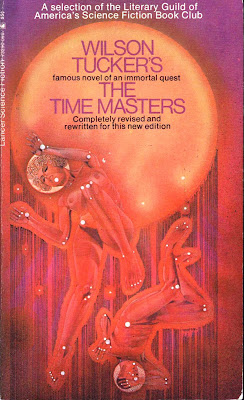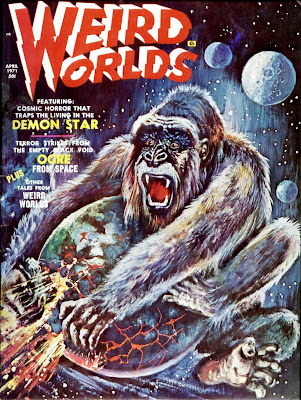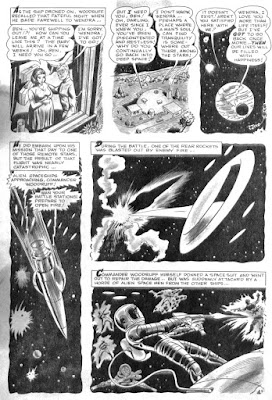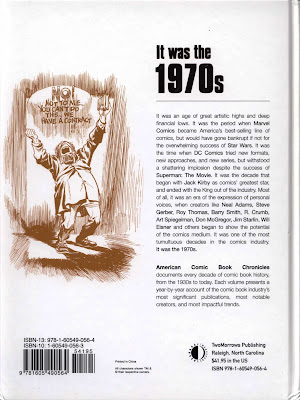Battle for the Planet of the Apes
Part I
by Doug Moench (script) and Vincente Alcazar and Sony Trinidad (art)
Planet of the Apes (Marvel / Curtis) No. 23, August 1976
July 1976, and on FM radio, 'Summer' by the group War is in heavy rotation.
In the latest issue (cover dated August, but on the shelves in early July) of Marvel's Planet of the Apes comic magazine, a 'Battle for the Planet of the Apes' story is being serialized; this one features content that didn't make it into the 1973 feature film. Doug Moench handles the writing chores.
Spanish artist Vincente Alcazar, and Filipino artist Sonny Trinidad, team up to provide outstanding artwork, with the imaginative use of layouts, silhouettes, and finely detailed linework. Very good stuff.........
The seven-part series concluded in issue 28 (the magazine was cancelled with issue 29).
I've posted Part One below.
Part Two is here.
Part Three is here.
Part Four is here.
Part Five is here.
Part Six is here.
Sunday, July 17, 2016
Thursday, July 14, 2016
Book Review: The Time Masters
Book Review: 'The Time Masters' by Wilson Tucker
1 / 5 Stars
This paperback edition (a revised version of the original 1953 novel) of ‘The Time Masters’ (160 pp) was published by Lancer Books in 1971; the cover artist is uncredited, but likely is Gene Szafran.
The novel is set in the early 70s, and takes place in Knoxville, Tennessee.
The opening chapters focus on the actions of a man named Gilbert Nash, who has captured the attention of a top-secret team of federal agents who are responsible for security and counterespionage at the Oak Ridge atomic research facility. Why their interest ? Because Nash has an uncanny history of placing himself in proximity to the most important dates and places in America’s atomic research program.
The feds have their suspicions about Gilbert Nash heightened when Gregg Hodgkins, a scientist working at Oak Ridge, consults with him over his marital problems- problems of a peculiar nature. For Hodgkins is complaining that his wife, a stunning woman named Carolyn, is not only far smarter than he, but able to read his mind.
Gilbert Nash doesn’t scoff at Gregg Hodgkins’ accusation, for Nash has his own suspicions about Carolyn Hodgkins……suspicions that go back not just decades, but centuries. For Gilbert Nash is one of a small number of unique people dwelling on the Earth……people who have mastered the art of enduring time………..
‘The Time Masters’ is less a sf novel and more of a mystery novel, with some sf trappings. This isn’t too surprising, for Wilson Tucker wrote mystery novels as well as sf. Unfortunately, this desire to imbue ‘The Time Masters’ with the quality of a mystery novel means that the narrative is slow-moving and overly focused on dialogue. Much of this dialogue is taken up with rambling philosophical exchanges that, in a labored way, inform the reader as to the unique nature of Gilbert Nash. Those few sf elements – such as telepathy – that do make it into the narrative have a contrived tone.
Summing up, while other of Tucker’s novels – The Year of the Quiet Sun comes readily to mind – are noteworthy examples of an imaginative treatment of the theme of time travel, ‘The Time Masters’ is a comparatively underwhelming effort. This one is for Tucker completists only.
1 / 5 Stars
This paperback edition (a revised version of the original 1953 novel) of ‘The Time Masters’ (160 pp) was published by Lancer Books in 1971; the cover artist is uncredited, but likely is Gene Szafran.
The novel is set in the early 70s, and takes place in Knoxville, Tennessee.
The opening chapters focus on the actions of a man named Gilbert Nash, who has captured the attention of a top-secret team of federal agents who are responsible for security and counterespionage at the Oak Ridge atomic research facility. Why their interest ? Because Nash has an uncanny history of placing himself in proximity to the most important dates and places in America’s atomic research program.
The feds have their suspicions about Gilbert Nash heightened when Gregg Hodgkins, a scientist working at Oak Ridge, consults with him over his marital problems- problems of a peculiar nature. For Hodgkins is complaining that his wife, a stunning woman named Carolyn, is not only far smarter than he, but able to read his mind.
Gilbert Nash doesn’t scoff at Gregg Hodgkins’ accusation, for Nash has his own suspicions about Carolyn Hodgkins……suspicions that go back not just decades, but centuries. For Gilbert Nash is one of a small number of unique people dwelling on the Earth……people who have mastered the art of enduring time………..
‘The Time Masters’ is less a sf novel and more of a mystery novel, with some sf trappings. This isn’t too surprising, for Wilson Tucker wrote mystery novels as well as sf. Unfortunately, this desire to imbue ‘The Time Masters’ with the quality of a mystery novel means that the narrative is slow-moving and overly focused on dialogue. Much of this dialogue is taken up with rambling philosophical exchanges that, in a labored way, inform the reader as to the unique nature of Gilbert Nash. Those few sf elements – such as telepathy – that do make it into the narrative have a contrived tone.
Summing up, while other of Tucker’s novels – The Year of the Quiet Sun comes readily to mind – are noteworthy examples of an imaginative treatment of the theme of time travel, ‘The Time Masters’ is a comparatively underwhelming effort. This one is for Tucker completists only.
Labels:
The Time Masters
Sunday, July 10, 2016
The Demon Star from Weird Worlds No. 3
The Demon Star
by Dick Ayers
from Weird Worlds No. 3, April 1971
I remember reading this story in Weird Worlds back in 1971 and thinking it was.....fantastic !
By the standards of the time, it was. The sf comics on the newsstands back then all adhered to the Comics Code, and many - particularly DC's anthology titles like Strange Adventures - were comprised of reprinted stories originally published in the 50s and 60s. These older comics were well-illustrated, but bland.
With 'The Demon Star', stalwart Eerie Publications artist - and comics veteran - Dick Ayers starts off on a downbeat note, with a spaceship crew shown dying in horrible fashion...... literally melting to death ! The story then segues into a series of flashbacks featuring bloody battles with a variety of aliens. True to form, Ayers concludes the tale with some of his trademark detached heads, eyeballs (and even - I think - a severed limb !).
The fatalistic, existential atmosphere of 'The Demon Star' made it stand out from all of the Code-restricted sf comics of its era.......and even today, makes it compare favorably with a lot of the shorter entries in anthologies like Dark Horse's rebooted Creepy Comics and Eerie.
It just didn't get any better back in '71......posted below is 'The Demon Star' in its entirety........
by Dick Ayers
from Weird Worlds No. 3, April 1971
I remember reading this story in Weird Worlds back in 1971 and thinking it was.....fantastic !
By the standards of the time, it was. The sf comics on the newsstands back then all adhered to the Comics Code, and many - particularly DC's anthology titles like Strange Adventures - were comprised of reprinted stories originally published in the 50s and 60s. These older comics were well-illustrated, but bland.
With 'The Demon Star', stalwart Eerie Publications artist - and comics veteran - Dick Ayers starts off on a downbeat note, with a spaceship crew shown dying in horrible fashion...... literally melting to death ! The story then segues into a series of flashbacks featuring bloody battles with a variety of aliens. True to form, Ayers concludes the tale with some of his trademark detached heads, eyeballs (and even - I think - a severed limb !).
The fatalistic, existential atmosphere of 'The Demon Star' made it stand out from all of the Code-restricted sf comics of its era.......and even today, makes it compare favorably with a lot of the shorter entries in anthologies like Dark Horse's rebooted Creepy Comics and Eerie.
It just didn't get any better back in '71......posted below is 'The Demon Star' in its entirety........
Labels:
The Demon Star
Thursday, July 7, 2016
American Comic Book Chronicles: The 1970s
American Comic Book Chronicles:
The 1970s
by Jason Sacks
TooMorrows Publishing, 2014
'American Comic Book Chronicles: The 1970s' (287 pp) is one of a series of books released by TooMorrows Publishing that chronicle the history of American comic books. Other volumes in the series cover the 1950s, the 1960s, and the 1980s.
This is a great book. If you are at all interested in American comic books, or American pop culture of the 70s, you will want to get it.
I was a big comic book fan in 1970, the initial year in this volume. I scrounged my pennies and nickels and dimes and bought several issues a month - almost always Marvel comics.
By the mid-70s my interest in comic books was waning, in part because of continuous rounds of price increases - back in those days, a dime or a quarter was a big chunk of change for a kid - and the page counts not only dropped, but in Marvel's case, were often made up of reprints.
I did get back into buying comics in the later 70s, but it wasn't comic books I bought, but rather, issues of Heavy Metal ........and some of what were being called 'graphic novels'.
Reading 'ACBC: The 1970s' brings it all back.
The book uses a narrative format, with each year receiving its own chapter, and a two-page Timeline that provides the major events in comic book publishing and in American history.
The book's coverage centers on the 'Big Two' publishers - Marvel and DC - but also covers, in lesser fashion, the comics issued by Charlton, Harvey, Archie, Gold Key, and even Dell.
The pages that I've scanned and posted here will give you a sense of the depth of coverage provided to the surveyed comics, as well as the personalities and businesses associated with the comics.
The narratives necessarily focus on the bigger events of the era, such as Jack Kirby's move to DC; the 1971 battles with the Comics Code over the Spider Man issues dealing with drug abuse; and the back-and-forth price wars between Marvel and DC in that same year.
Also getting attention are the rise, and steep fall, of the underground comix during the early 70s; the success of the Warren black and white magazines, and the rise of Marvel as the dominant comic book publisher in the industry.
The latter chapters deal with the increasingly unprofitable condition of the industry, dependent as it was on a network of some 500 independent distributors to place the comics on the shelves and racks in retail stores - and truthfully report sales figures.
One thing 'ACBC: The 1970s' does very well is reveal the precarious economics that governed the industry throughout the decade, and left Marvel near bankruptcy in 1977 - according to Jim Shooter, only the massive success of Star Wars saved the company.
DC failed to find as successful a franchised property, and, as the book relates, in 1978 suffered the disastrous 'DC Implosion' that led to layoffs, cancelled books, and a retrenchment that lingered well into the early 80s.
Economic troubles increasingly characterized the industry in the latter half of the decade, although there were signs that the public was ready to embrace alternate comics, particularly if these adopted the European attitude towards graphic art - as Heavy Metal magazine was to discover.
The book closes on a sobering note: at the start of the decade, the average Marvel or DC comic book cost 15 cents and provided around 20 pages of new content. By the end of 1979, the average comic book cost 40 cents and provided 17 pages. In 1970, Archie, one of the industry's biggest sellers, sold an average of 483,000 copies a month. In 1977, sales dropped to 155,000 per month, and in 1983, to 70,000 per month.
This troubling picture of declining sales was true for every comics publisher as the 1970s ended. Many inside and outside the industry predicted that comic books were fated to die out, much as the pulp magazines had died out during the 1950s. As we now know, the industry would undergo a revival of fortune in the early 1980s, but as 1979 came to an end, the overall picture was bleak.
Summing up, I reiterate: you'll need to get a copy of 'American Comic Book Chronicles: The 1970s'. The combination of tiny, fact-packed font, and high-quality illustrations, means this is one book you're going to have hard time putting down.........
The 1970s
by Jason Sacks
TooMorrows Publishing, 2014
'American Comic Book Chronicles: The 1970s' (287 pp) is one of a series of books released by TooMorrows Publishing that chronicle the history of American comic books. Other volumes in the series cover the 1950s, the 1960s, and the 1980s.
This is a great book. If you are at all interested in American comic books, or American pop culture of the 70s, you will want to get it.
I was a big comic book fan in 1970, the initial year in this volume. I scrounged my pennies and nickels and dimes and bought several issues a month - almost always Marvel comics.
By the mid-70s my interest in comic books was waning, in part because of continuous rounds of price increases - back in those days, a dime or a quarter was a big chunk of change for a kid - and the page counts not only dropped, but in Marvel's case, were often made up of reprints.
I did get back into buying comics in the later 70s, but it wasn't comic books I bought, but rather, issues of Heavy Metal ........and some of what were being called 'graphic novels'.
Reading 'ACBC: The 1970s' brings it all back.
The book uses a narrative format, with each year receiving its own chapter, and a two-page Timeline that provides the major events in comic book publishing and in American history.
The pages that I've scanned and posted here will give you a sense of the depth of coverage provided to the surveyed comics, as well as the personalities and businesses associated with the comics.
The narratives necessarily focus on the bigger events of the era, such as Jack Kirby's move to DC; the 1971 battles with the Comics Code over the Spider Man issues dealing with drug abuse; and the back-and-forth price wars between Marvel and DC in that same year.
Also getting attention are the rise, and steep fall, of the underground comix during the early 70s; the success of the Warren black and white magazines, and the rise of Marvel as the dominant comic book publisher in the industry.
The latter chapters deal with the increasingly unprofitable condition of the industry, dependent as it was on a network of some 500 independent distributors to place the comics on the shelves and racks in retail stores - and truthfully report sales figures.
One thing 'ACBC: The 1970s' does very well is reveal the precarious economics that governed the industry throughout the decade, and left Marvel near bankruptcy in 1977 - according to Jim Shooter, only the massive success of Star Wars saved the company.
DC failed to find as successful a franchised property, and, as the book relates, in 1978 suffered the disastrous 'DC Implosion' that led to layoffs, cancelled books, and a retrenchment that lingered well into the early 80s.
Economic troubles increasingly characterized the industry in the latter half of the decade, although there were signs that the public was ready to embrace alternate comics, particularly if these adopted the European attitude towards graphic art - as Heavy Metal magazine was to discover.
The book closes on a sobering note: at the start of the decade, the average Marvel or DC comic book cost 15 cents and provided around 20 pages of new content. By the end of 1979, the average comic book cost 40 cents and provided 17 pages. In 1970, Archie, one of the industry's biggest sellers, sold an average of 483,000 copies a month. In 1977, sales dropped to 155,000 per month, and in 1983, to 70,000 per month.
This troubling picture of declining sales was true for every comics publisher as the 1970s ended. Many inside and outside the industry predicted that comic books were fated to die out, much as the pulp magazines had died out during the 1950s. As we now know, the industry would undergo a revival of fortune in the early 1980s, but as 1979 came to an end, the overall picture was bleak.
Summing up, I reiterate: you'll need to get a copy of 'American Comic Book Chronicles: The 1970s'. The combination of tiny, fact-packed font, and high-quality illustrations, means this is one book you're going to have hard time putting down.........
Monday, July 4, 2016
Book Review: Algorithm
Book Review: 'Algorithm' by Jean Mark Gawron
0 / 5 Stars
‘Algorithm’(211 pp) was published by Berkley Books in 1978. The cover artist is uncredited but appears to be Paul Alexander.
Jean Mark Gawron (b. 1953) is U.S. sf writer who published three novels during the 70s and early 90s.
According to dates provided at the end of the novel, author Garwon wrote ‘Algorithm’ during 1973 and 1976, which explains a lot; namely, the book’s overindulgence in the worst aspects of the New Wave’s prose stylings.
I’ve read quite a few really bad New Wave era sf novels, and ‘Algorithm’ is one of the worst. It’s so bad that after several efforts to read it, I gave up. I never finished it.
0 / 5 Stars
‘Algorithm’(211 pp) was published by Berkley Books in 1978. The cover artist is uncredited but appears to be Paul Alexander.
Jean Mark Gawron (b. 1953) is U.S. sf writer who published three novels during the 70s and early 90s.
According to dates provided at the end of the novel, author Garwon wrote ‘Algorithm’ during 1973 and 1976, which explains a lot; namely, the book’s overindulgence in the worst aspects of the New Wave’s prose stylings.
I’ve read quite a few really bad New Wave era sf novels, and ‘Algorithm’ is one of the worst. It’s so bad that after several efforts to read it, I gave up. I never finished it.
‘Algorithm’s plot is superficial; is apparently deals with a near-future America in which assassination is a sport that is extravagantly covered by the media. The primary goal of this novel is not to entertain, but rather, to demonstrate the author’s use of Speculative Fiction to Conduct Profound Explorations of the Nature of Language, and Human Self-Identity.
Most of the narrative wallows in the figurative, metaphor- and simile-drenched prose favored by Speculative Fiction writers of the New Wave era, like Samuel R. Delaney (apparently ‘Algorithm’ is Gawron’s homage to Delaney) and to non-genre writers like Thomas Pynchon, John Barth, and Kurt Vonnegut.
Reading ‘Algorithm’ means you’re going to have to wade through these types of passages:
"One day you’ll pay for those excesses. Besides, your execrable decadence has caused you to overlook possibly the most interesting item of all. Tom Bremmer the Deullist. His report is a horrified survey of the assassin’s effect on his profession. Bremmer, as you probably don’t know, is the lord high muck-a-muck pacifist, who will only do violence for others, never for his own gain. He is admirably appalled at the 200% increase in cyborg duelist overhauls, and the 750 % rise in professionally associated duels in general…."
***
Fear sheened his vision of the giantess that first day when, her victimhood first declared, she betrayed a chilling delight. And why ? When he watched there was fear. When he was seen there was nothing.
The fire still flung wobbling light into this first bubble of rock, wove shadows ahead of them, dashed ocher up rounded walls. There was a downgrade tilted level by the prankster light and Danton’s first step missed and he skidded, gasping, ahead of the Juggler.
The verdict ? Only the most fervent of New Wave fans are going to even want to contemplate, in a vague and detached way, trying to read this novel. Indeed, its main value to the genre is to illuminate just how bad things were in the years before the advent of cyberpunk................
Most of the narrative wallows in the figurative, metaphor- and simile-drenched prose favored by Speculative Fiction writers of the New Wave era, like Samuel R. Delaney (apparently ‘Algorithm’ is Gawron’s homage to Delaney) and to non-genre writers like Thomas Pynchon, John Barth, and Kurt Vonnegut.
Reading ‘Algorithm’ means you’re going to have to wade through these types of passages:
"One day you’ll pay for those excesses. Besides, your execrable decadence has caused you to overlook possibly the most interesting item of all. Tom Bremmer the Deullist. His report is a horrified survey of the assassin’s effect on his profession. Bremmer, as you probably don’t know, is the lord high muck-a-muck pacifist, who will only do violence for others, never for his own gain. He is admirably appalled at the 200% increase in cyborg duelist overhauls, and the 750 % rise in professionally associated duels in general…."
***
***
The fire still flung wobbling light into this first bubble of rock, wove shadows ahead of them, dashed ocher up rounded walls. There was a downgrade tilted level by the prankster light and Danton’s first step missed and he skidded, gasping, ahead of the Juggler.
[A lengthy review of ‘Algorithm’ that is just as incoherent as the novel itself can be access at this link.]
Labels:
Algorithm
Saturday, July 2, 2016
Subscribe to:
Posts (Atom)















































































